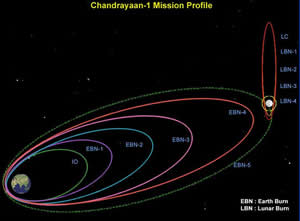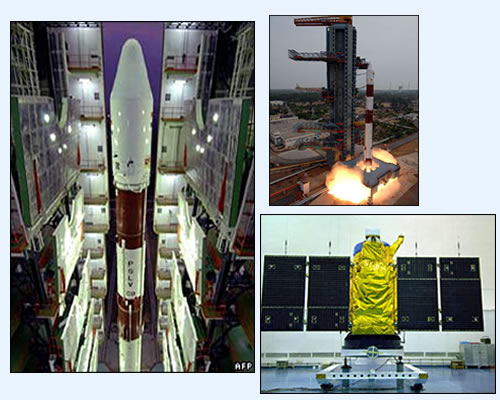INDIAN SPACE RESEARCH
Reaching Far Lands For Humanity..
|
In the above flash are the Satellite launch vehicles the work horses of Indian Space program. More info can be seen here on Launch vehicles of ISRO . Please use the sub links on the right to navigate through the Indian Space Program. |
India being a developing economy, is confronted with many socio economic problems, which generally receive the first preference. In spite of this Indian Space program has evolved to such a state that it is now second to none. The recent chandrayaan-I and before that by simultaneously and precisely launching Ten satellites India has proved its strength in Space research. It is now also planning a man mission to space.Indian Space Research Organisation(ISRO) is the primary body looking after Space Research in India, it is under the control of Government of India.ISRO was started in 1969. From then onwards it got shaped under many eminent scientists.
|
|
Many Milestones in The Never Ending Journey.
Click Here to view the milestones of India Space Research. |
The history of ISRO started with the experiments phase in 1970s when experimental satellites like Aryabhatta, Bhaskara, Rohin, Apple were launched. The success of the programs left to the operationalisation of advanced programmes like INSAT, IRS were started in 1980s. India has now the worlds largest network of remote sensing satellites. When India first detonated a nuclear device in 1974, it has to face many tough financial, technology sanctions by US and European countries. This is to curtail India's Missile building program. This had an adverse Impact on India's Space programme.This forced to reinvent technologies, as the advanced countries closed their doors. This has helped India a lot in designing its own independent space program. It is now highly self sufficient and is now planning to be completely independent of foreign support. From the Times when its first rocket, Satellite Launch Vehicle which crashed in to Bay Of Bengal it now reached to stage of Geosynchronous and Polar Satellite Launch vehicles. The journey is inspirational for not only Third world countries but also to the advanced countries. |
India's space program is already a money-earner. ISRO sells infrared images from its remote-sensing satellites to other countries, including the US, where they are used for mapping. And the Technology Experiment Satellite, launched in October 2001, is beaming back images of the Earth's surface with a resolution of 1 metre, though they are not yet available commercially.
Does for a country like India which is home for the world's largest number of Poor?Malnutrition people? require all this space research and all this Moon missions? Definitely yes. Here we try to provide some information, how the Indian Space program is benefiting the nation.
Indian Space Program Benefits
The imaging satellites of ISRO are used to take infrared images are used to measure the reflectivity of the plant covered surfaces. By this it can be distinguished whether it is a rice, wheat crop etc. It can also be determined whether the crops are well watered. It can also be predicted whether the crop will fail or not. By this the yield can be forecasted one month before the harvest. In this way , the government can plan for food shortages.
Ensuring a supply of clean drinking water is a problem in many parts of rural India. Villagers often resort to guessing the right spot to drill a well based on experience, but it is a hit-and-miss affair. Topographic and hydrological maps produced from satellite images help rural communities locate areas most likely to yield underground water. The success rate for drilling wells has gone up from 45 to 90 per cent.
The next step is to use the same information to work out where to build small dams to capture rainwater and recharge underground reservoirs. This approach could help reclaim arid and semi-arid land for agricultural use.
ISRO's satellites are also having an impact at sea. OCEANSAT, launched in 1999, monitors the chlorophyll content of oceans and the sea surface temperature. ISRO scientists use the information to identify areas where cold, nutrient-rich water wells up from the ocean floor, which in turn attract fish.The coordinates of these areas are then sent to more than 200 coastal centres. The upwellings last for several days - meaning the areas identified contain high concentrations of fish - long enough for fishermen to arrive and gather a sizeable catch. Fish catches have been reported be doubled in the last decade.
Apart from remote sensing, India operates eight communication satellites. They are now being used by around 35,000 customers mostly from India. Hadn't been the satellites are launched by ISRO, they would have gone to foreign satellites, thus losing a good amount of foreign exchange.ISRO also played a major role in Disaster warning systems. In cyclones a prior information just few hours before can save lives of thousands. In 1977 a cyclone that hit Costal Andhra resulted in 10,000 deaths. In 1990s with the advancement of remote sensing and communication satellites , the death toll was reduced to 900, thus mitigating the adverse affect of deadly cyclones.
In addition there are many ambitious plans in ambit. The EDUSAT launched recently was the world's first satellite which is completely dedicated for education purposes. Already some 70 odd hospitals of remote Andaman were linked with the hospitals of main land India, so that advance medical treatment can be given to the patients of the distant land.
So ISRO stood for its objective, the dream of Sri. Vikram Sarabhai.In His words.
There are some who question the relevance of space activities in a developing nation. To us, there is no ambiguity of purpose. We do not have the fantasy of competing with the economically advanced nations in the exploration of the moon or the planets or manned space-flight. But we are convinced that if we are to play a meaningful role nationally, and in the community of nations, we must be second to none in the application of advanced technologies to the real problems of man and society.Chandrayaan-- Everyone amused!!!

- The Path of Chandryaan

 It launched many satellites and now is launching commercially the satellites of other countries. The reliability of Indian Satellite Launch Vehicles was proved again and again.
It launched many satellites and now is launching commercially the satellites of other countries. The reliability of Indian Satellite Launch Vehicles was proved again and again. 